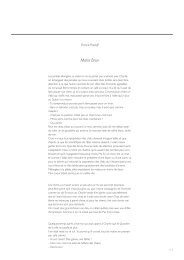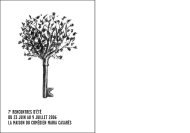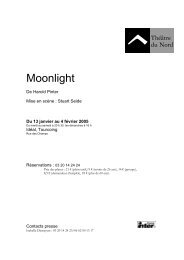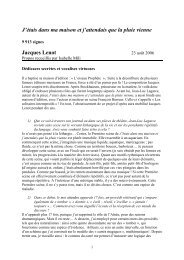E PAIN NU - biladi rolling theatre
E PAIN NU - biladi rolling theatre
E PAIN NU - biladi rolling theatre
- No tags were found...
You also want an ePaper? Increase the reach of your titles
YUMPU automatically turns print PDFs into web optimized ePapers that Google loves.
The scene, place of perpetual metaphors.We worked on the emptyness of stage, whichgives to the only actor’s performance, all theincarnations and meanings.So the actor's body became the matter of thewhole performance.Because this is what the text deals with: life,conceived as a story of the body needs. From abody caught in the network of social determinismthat are poverty, morality, sexuality in theProtectorate of Morocco.Therefore, the actress, alone on the stage,interprets in turn not only all the characters, butalso where the text requires, a tree, a flock, thefamine.So goes it also with the rare objects, metaphorisedby the use to which they are put. From a floorcloth,we made a chicken, then Mohamed Shukri's littlesister , and then again a floorcloth and a honey pie.A moroccan showLooking increasingly for a proper theatricallanguage, we have gone to the roots of traditionalspectacular forms of Morocco. Therefore, theshow will sometimes turns into the way of theMoroccan popular <strong>theatre</strong> itself: Halqa, wherecrowd forms a circle around the actor, as we stillfind some on the the Jamâa - Fna place inMarrakech.And last but not least, we picked up, in theMoroccan society, a further understanding of thedescribed situations. To serve us as a matter ofgestures and characters that the actress, whogrew up in this country, carries with her.La scène, le lieu de métaphores perpétuelleComme s'il s'agissait du pain lui-même, nous avonstravaillé sur la nudité de l'espace scénique quidélègue au seul jeu du comédien l'ensemble desincarnations et des significations. Alors le corps del'acteur est devenu la matière même du spectacle.Parce que c'est de cela dont traite le texte : la vie,conçue comme une histoire des besoins du corps.D'un corps pris dans le réseau des déterminismessociaux que sont la misère, la morale, la sexualité,dans le Maroc du Protectorat. Dès lors, l'actrice,seule sur scène, interprète tour à tour, nonseulement l'ensemble des personnages, maisaussi, là où le texte l'exige, un arbre, un troupeau, lafamine. Ainsi en va-t-il également des rares objets,que l'usage qui en est fait, métamorphose. D'uneserpillière, nous avons fait une poule, puis la petitesoeur de Mohamed Choukri, puis à nouveau uneserpillière, puis une galette de miel.Un spectacle marocainEn quête d'un langage toujours plus proprementthéâtral, nous avons puisé dans les formesspectaculaires traditionnelles du Maroc. Aussi, lespectacle ne va-t-il pas, parfois, sans rappeler lafaçon du théâtre populaire marocain: le Halqa, où lafoule forme un cercle autour des acteurs, tel qu'onen trouve encore certains avatars sur la placeJamâa le-Fna de Marrakech. Enfin, un des axes dutravail a été d'aller chercher dans la réalité de lasociété marocaine une compréhension plus ampledes situations évoquées. De nous servir de lamatière gestuelle et des personnages que l'actrice,ayant grandit dans ce pays, porte en elle.
















